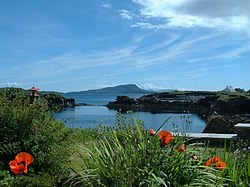Seil
| Seil Gaelic: Saoil | |
 From Ellenabeich village over Easdale Sound to Scarba | |
|---|---|
| Main settlement: | Ellenabeich |
| Location | |
| Location: | 56°18’-0"N, 5°37’12"W |
| Grid reference: | NM742172 |
| Area: | 3,284 acres |
| Highest point: | Meall Chaise, 479 feet |
| Data | |
| Population: | 551 |
Seil is one of the Slate Islands of the Inner Hebrides. It is a small island on the east side of the Firth of Lorn, 7 miles southwest of Oban in Argyllshire, to which county the island belongs. Seil has been linked to the mainland by stone bridge since the late eighteenth century.
Sights about the island
The Bridge over the Atlantic
In 1792 the Clachan Bridge was built by engineer Robert Mylne, linking Seil to mainland Great Britain, and the bridge, still in use, is known affectionately as the "Bridge Over the Atlantic". In early summer the bridge is covered in fairy foxgloves (Erinus alpinus).
Life ashore
Balvicar, in the centre of the island, is the main settlement with a flourishing fishing industry, the island shop, and a high percentage of houses that are occupied all year round. At the end of the road lies the former slate-mining village of Ellenabeich. This picturesque village is a conservation area with a high percentage of holiday cottages and is fully occupied only in the summer months. Parts of Ring of Bright Water were filmed here.
The Ellenabeich Heritage Centre which opened in 2000, is run by the Scottish Slate Islands Trust. Located in a former slate quarry-worker's cottage, the centre has displays on life in the 19th Century, slate quarrying and the local flora, fauna and geology.[1] Ferries sail from Ellenabeich to Easdale, and from Cuan on the island to Luing.
The mother of Princess Diana, Frances Shand Kydd, at Ellenabeich there until her death in 2004.
History

Rae (2011) has argued that Seil could be the location of Hinba, an island associated with St Columba. His reasons include the island's association with St Brendan, its location on an inshore trade route from Antrim to the north and its suitability for a substantial settlement. He suggests that the Muirbolcmar (great sea bag) referred to in texts about Hinba could refer to the Seil Sound and narrows at Clachan Bridge where the "bag" captures the rapidly flowing water that floods under the bridge and also argues for this location on etymological grounds. Equating "Hinba" with the Gaelic Inbhir, he notes that the adjacent mainland parish of Kilninver means "church of Inbhir" and suggests that the derivation of "Seil" maybe of Scandinavian origin with similarities to the East Frisian place name Zijl or Syl meaning a "seep or passage of water". This, he proposes, could have been a Norse interpretation of Hinba/Inbhir.[2][3]|group="Note"}}
It has also been suggested that Seil may be the Innisibsolian referred to in the Chronicle of the Kings of Alba, which records a victory of the Scots over a Viking force during the time of King Donald II in the 9th century.[4]
Outside links
| ("Wikimedia Commons" has material about Seil) |
References
- ↑ "Ellenabeich Heritage Centre". Gazetteer for Scotland. http://www.scottish-places.info/features/featurefirst10016.html. Retrieved 2007-07-25.
- ↑ Rae (2011) pp. 3-11
- ↑ Mac an Tàilleir (2003) p. 72
- ↑ Hudson (1998) p. 9
- Hudson, Benjamin T. (October 1998) "The Scottish Chronicle". Scottish Historical Review. 77. Issue 204.
- Rae, Robert J. "A Voyage in Search of Hinba" in Historic Argyll (2011) No. 16. Lorn Archaeological and Historical Society. Edited by J Overnell
| The Slate Islands |
|---|
|
Belnahua • Easdale • Fladda • Luing • Lunga • Seil • Shuna • Torsa |